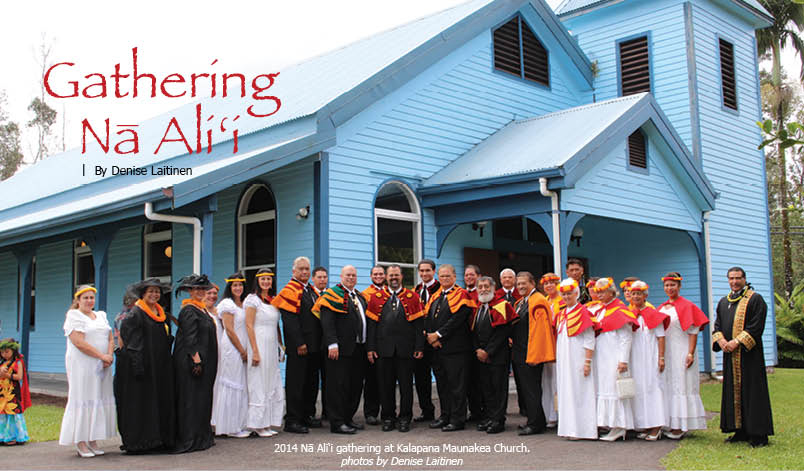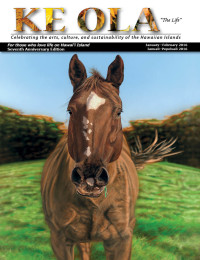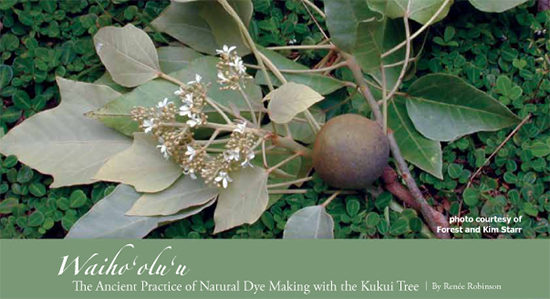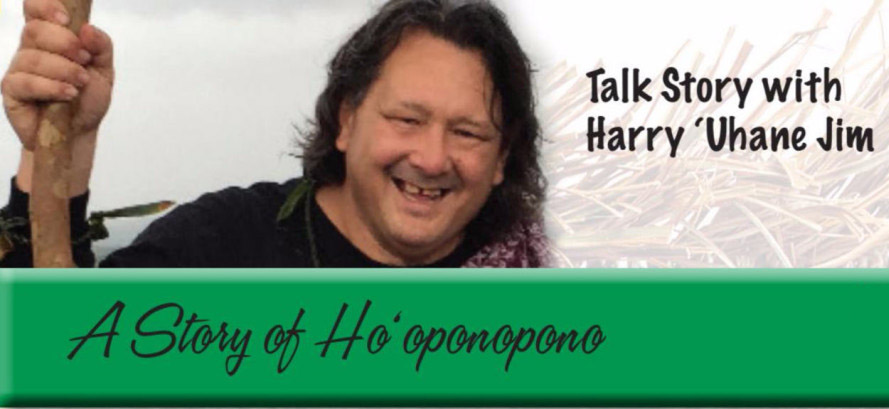
Gathering Na Ali‘i
 This March an inspirational event will take place on a Sunday morning in a small Hawaiian church in lower Puna. The event is Nā Ali‘i Sunday—a gathering of royal societies that will come together to honor both God and Nā Ali‘i (royalty) through song and verse at Kalapana Maunakea First Hawaiian Congregational Church in Nanawale Estates.
This March an inspirational event will take place on a Sunday morning in a small Hawaiian church in lower Puna. The event is Nā Ali‘i Sunday—a gathering of royal societies that will come together to honor both God and Nā Ali‘i (royalty) through song and verse at Kalapana Maunakea First Hawaiian Congregational Church in Nanawale Estates.
While the royal societies themselves date back to the 1860s and get together throughout the year for different cultural events, this is the only time of the year when they come together in a single church service.
It all started a little more than five years ago when Aunty Loke Kamanu of Mountain View was reading old church newspapers.
“I found out about the Nā Ali‘i Sundays by reading about them in old literature in newspapers at churches on O‘ahu,” says Aunty Loke. “Then I started reading more and learning more.”
Aunty Loke, who has attended Kalapana Maunakea church for more than a decade, is also a member of a royal society, Hale o Nā Ali‘i O Kalakaua in Hilo, which is part of the Hale O Nā Ali‘i O Hawai‘i royal society.
In November 2009, she brought up the idea of holding a Nā Ali‘i event.

“Since I’m the sergeant at arms for Hale O Nā Ali‘i, I approached my society first, and they were receptive of the idea, and then I approached my church.”
It wasn’t until she brought the idea to the church’s priest, or kahu, that she learned he was also a member of a royal order. Kahu Mike Warren is a member of the Royal Order of Kamehameha I and welcomed the idea of bringing the royal societies together. (See Jul–Aug 2014 Ke Ola for a history of the Royal Order of Kamehameha I.)
“There was no other church having this kind of service,” says Kahu Mike. Holding the event at Kalapana Maunakea church was fitting since the 192-year-old congregation is the oldest in the area. “Our church is the oldest Hawaiian church in East Hawai‘i, older than Haili Church in Hilo.”
It should be noted that the various royal societies each hold events honoring ali‘i. Some of these events are held in churches and some are at cultural events. For instance, ‘Ahahui Ka‘ahumanu holds services honoring ali‘i at Haili Church. Or the royal societies might come together for special occasions, such as the draping of lei on the King Kamehameha statue in honor of King Kamehameha Day.
“When you put a ‘Nā’ in front of it you are including all the ali‘i societies because Nā means plural,” explains Aunty Puanani of ‘Ahahui Ka‘ahumanu.
What makes the gathering at Kalapana Maunakea Church unique is that it brings multiple royal societies together to honor Nā Ali‘i.
With the help of Ku‘ulei Hughes, president of Hale O Nā Ali‘i O Kalakaua O Helu Elua, Aunty Loke sent invitations to the secretary of each of the other royal orders and societies. “We sent invitations to four societies, and three of them said yes.”
“In the planning stages we decided that we would eat afterwards,” says Aunty Loke. “We worship together then we eat together. However, we made it clear that they would be required to sing at least one mele (song).”
Kalapana Maunakea itself has a rich musical history. On any given Sunday you’ll hear hymns and songs in Hawaiian. The origins of the church date back to 1823, when a church made of pili grass was built as a mission station after Reverend William Ellis and three missionaries visited Kaimū and Kalapana. (See May–Jun 2015 Ke Ola for an article on churches in lower Puna.)
One of the church’s greatest musical accomplishments took place in 1886, when 60 members of the church’s choir walked for three days from Kalapana to Hilo to participate in the Aha Mele, an annual statewide song contest being held at Haili Church. The Kalapana choir won first place and received a silver flagon and chalice from then-Princess Lili‘uokalani.
Recalling the first Nā Ali‘i gathering at the Kalapana Maunakea Church, Aunty Loke says there was concern about asking the royal organizations to perform at the church service. “There was controversy over that because we were inviting them as guests, but then we were asking them to perform.”
“In the end, we decided to give them the opportunity to sing—we made it a “could do” instead of a “have to do.” What we found was that the various royal societies all wanted to sing.”
Following Protocol
As with other Hawaiian cultural practices, there are protocols that need to be followed.
Kahu Mike says although he is a member of the Royal Order of Kamehameha I, he did not participate as a member, since he is also the kahu of the church.
“When I’m at the church I’m the kahu, so I didn’t participate in the formation of the Royal Order. It’s not that the kahu is above the ali‘i, but we always put God first, so the kahu enters the church first, then the Royal Order of Kamehameha I, then the royal societies. We have special sections where the royal order and societies sit on one side of the church and everyone else sits on the other side.”
Aunty Loke says that even though she is a member of a royal society, she still learned things about protocol when it came to interacting with the other societies.
“For instance, I learned don’t touch the [Royal Order of Kamehameha] men’s cape!” The capes, called ‘ahu, are considered sacred.
“In the beginning we go around and greet each other. We had to figure out how to give them a greeting without touching the cape because the capes are kapu. A traditional Hawaiian greeting, or honi, is where two people lean in and touch foreheads then touch noses and inhale a breath together.
“Since I organized the event, I was the first one to give a greeting. The first gentleman I went to [in the Royal Order], I touched his cape and he said no. He held out his hand under his cape so I could hold his hand and could then lean in to touch our heads together and then our noses.”
Protocol also pertains to songs that can be sung. “Na Himeni O Ka Ekalesia is the name of the hymn book we use and it contains mele (song) that were written as far back as 1907.
“There are protocol in terms of songs that are played and hymns that are sung when we bring ali‘i and maka‘āinana together in worship,” says Aunty Loke. Each royal society also has their own signature song that they sing during such an event.
“It really meant a lot the first time we did it that the people coming from the royal societies were really excited to be honored in a Hawaiian church,” says Kahu Mike. He says for his church’s part, they were equally thrilled to host the royal societies.
“It was an honor to have the royal societies here.” All the more so, since Kalapana Maunakea church is tucked deep in lower Puna far off the beaten path within Nānāwale.
After the church service, the members of the different groups relax and spend time together. “We eat and talk story. The day itself is a great time,” says Kahu Mike. “Culturally, I think it’s important to bring our royal societies together in the church.” For their part, members of the royal societies, enjoy attending the annual event.
“It’s an honor to be invited and to participate in Nā Ali‘i Sunday at Kalapana Maunakea Church,” says Catherine Kamau, who is pelekikena (president) of ‘Ahuhui Ka‘ahumanu Society Helu ‘Ekolu (Hilo chapter). “Thank you to Loke and Kahu Mike for really bringing us together in a celebration like this.”
Catherine and former Hilo Chapter Pelekikena Pualani Crumb point out that the Hilo Chapter of ‘Ahuhui Ka‘ahumanu has held Ali‘i Sunday events at Haili Church for many years. Those events are of a single royal society honoring an ali‘i, such as Queen Ka‘ahumanu or Princess Kamāmalu.
Since Kalapana Maunakea church started the Nā Ali‘i annual gathering, other churches around the state are bringing it back, says Kahu Mike.
“Now other churches are starting to do their own Nā Ali‘i gathering. They’re calling us to find out more about our event.” He notes that Kapa‘a First Hawaiian Church on Kaua‘i held a Nā Ali‘i gathering last year and a church on Maui also held one.
Kahu Mike is quick to point out that the churches hosting the Nā Ali‘i gatherings are not all the same denomination, nor do members of the different royal societies all belong to the same church.
He adds that the Nā Ali‘i gathering has been growing during the past five years as they invite more chapters of the various royal societies.
“Every year we do something a little different. This year we’re looking at holding Nā Ali‘i on the first Sunday of March, known as Holy Communion Sunday or ‘Ai Palena.
“We usually wear black and white for our Holy Communion Sunday and thought it would be even more powerful to have the royal order and societies there in their regalia. For people who are very pious, ‘Ai Palena is a very important occasion.”
In addition to religious elements, Kalapana Maunakea church has been incorporating more Hawaiian elements to the gathering. “We’re getting more and more cultural. We’re taking it back more to what it was like in the mid-1800s,” he explains.
“This year we have two kāhili that we’re making. They’re being made in the colors of the church so we’ll have the kāhili in the front of the procession. For Nā Ali‘i Sunday we see more people dressing in Hawaiian formal wear too. Some women even wear the type of holokū (a loose seamed dress with a yoke and a train) and mu‘umu‘u that was popular during the mid-1800s or formal Hawaiian wear.”
The annual gathering is now something that the groups eagerly anticipate and are a tradition to be passed on to the next generation. “Everyone looks forward to it every year,” says Aunty Loke. “We want to continue our traditions with younger members in our societies and teach our youth.” ❖
For more information on the Nā Ali‘i gathering at Kalapana Maunakea Church, 808.965.9961
Contact writer and photographer Denise Laitinen
Hawaiian Benevolent Royal Societies
The first royal benevolent society in Hawai‘i dates back to 1864 when Princess Victoria Kamāmalu formed ‘Ahuhui Ka‘ahumanu, also known as the Ka‘ahumanu Society, in honor of Queen Ka‘ahumanu. In 1865 Princess Victoria’s brother, King Kamehameha V, (Lot Kapuāiwa), formed the Royal Order of Kamehameha I in honor of his grandfather, King Kamehameha I.
While each royal society’s mission is slightly different, the overarching goal is to maintain and preserve Hawaiian culture, as well as provide assistance to those in need, ill health, or dying.
In Hawai‘i there are four royal societies:
The Royal Order of Kamehameha I
‘Ahahui Ka‘ahumanu
Hale O Nā Ali‘i O Hawai‘i
Daughters and Sons of Hawaiian Warriors—Māmakakaua
Each society, comprised of people of Hawaiian descent, is organized differently and have multiple chapters across the state. For instance, the Royal Order of Kamehameha I, of which kāne (men) are members, has a wahine (women) auxiliary organization, Nā Wāhine Hui O Kamehameha, whose members are usually wives or family members of men who belong to the Royal Order. The Royal Order of Kamehameha I has nine different chapters that represent different geographical areas of the state. Hawai‘i Island has three chapters: one includes Hilo, Puna, Hāmākua, and Ka‘ū, Kona, and Kohala. Similarly, ‘Ahahui Ka‘ahumanu has four chapters on Hawai‘i Island in Hilo, Kona, Waimea, and Kohala.
Hale O Nā Ali‘i has seven chapters across the state called hālau. Thus, the Hilo chapter that Aunty Loke is a member of is called Hale O Nā Ali‘i O Kalakaua Helu Elua, meaning that it was the second chapter established after Hale O Nā Ali‘i Hawai‘i on O‘ahu.
The royal societies saw periods of inactivity in the late 1800s and some, like the Royal Order of Kamehameha I, went underground after the overthrow of the Hawaiian government in 1893. Each of the societies started or restarted at different times in the early 20th century. The Royal Order of Kamehameha I was relaunched in 1903 while ‘Ahuhui Ka‘ahumanu reorganized in 1905. The Daughters and Sons of Hawaiian Warriors—Māmakakaua was formed in 1917 with Hale O Nā Ali‘i O Hawai‘i forming the following year.


